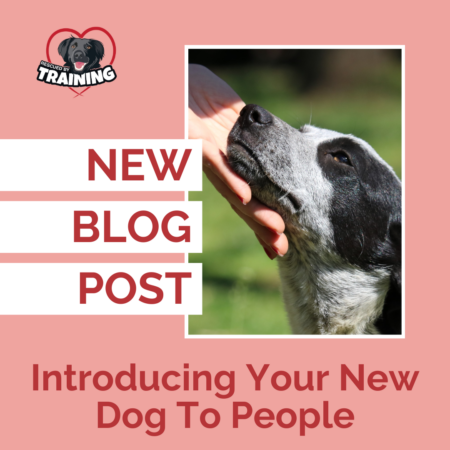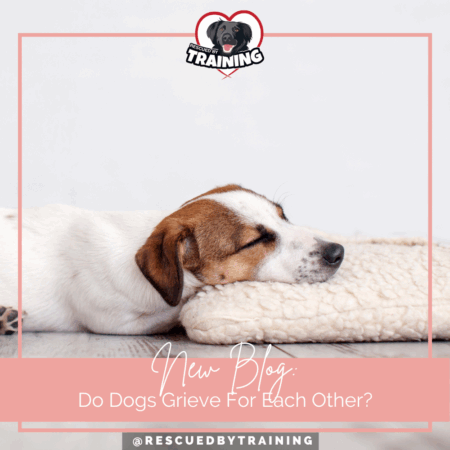So you’ve brought home a new dog (or are preparing to do so)! Congratulations on your new addition! I bet you’re excited to show off your new bundle of joy to everyone! And that’s understandable! But first, let’s look at some important things to help keep your new dog safe, and everyone else safe. Giving your new dog a chance to settle in and be comfortable with you is critical to success long-term. I suggest 1-3 weeks for this settle in period, depending on the dog’s age, socialization history and such. If your dog is a new puppy, under the age of 14 weeks then it’s time to get cracking on socialization, even if they’re not fully vaccinated.
Today’s post is going to cover some best practices on how to introduce your dog to new people, including to those people who may be at higher risk for injuries or being knocked over. Extra precautions should be taken when introducing dogs to children, especially toddlers or unpredictable children. Hopefully by the time you’re deciding it’s a good idea to let your dog interact with strangers, you’ve had them long enough to learn a bit about them, their mannerisms, any fears or dislikes and their body language. The focus should always be on the dog’s body language so you can keep them safe.
Reading body language, knowing your dog’s subtle stress signs and knowing when to help give your dog a break is also really important. Don’t wait for your dog to be growling, lunging, barking or snarling to relieve them. If you need help understanding dog communication, download my free handout here.
People often ask “What’s the best way to greet a dog?” and they’re surprised when I say, “You don’t. Dogs are social creatures. If they want to have an interaction with you, you’ll know.” Dogs who are social and want to be touched will be very clear in their body language. We’ve all seen wiggly, happy dogs who clearly want interaction. And by all means, that dog likely wants to have an interaction with you. But the dogs who don’t proactively initiate contact or don’t communicate with their body language that they are looking for an interaction – those dogs should be left to decide if you’re safe or not and left to decide if, or when, they want to have an interaction. This is why I like to train consent cues and teach dogs they can always say no and opt out if they are uncomfortable.
A caveat – some fearful dogs will approach and that doesn’t mean they want an interaction. Some will approach with the intent of creating distance to make you go away because they think you’re scary. Those dogs may lunge, jump or otherwise communicate they’re uncomfortable. Other fearful dogs may approach to investigate – sort of a “fact-finding” mission, to determine if you’re safe. These dogs may be a little conflicted. They may sort of want an interaction but they’re unsure. Often we will see a “stretch investigation” where they stretch the front part of their body to sniff or get close but their back legs are planted in case they need to make a getaway. If you suddenly reach down to pet or try to feed the dog, you’ve likely just confirmed to the dog by invading their personal space, that you’re not safe.
Let’s think of it like this. You’re walking through Times Square and you see an odd character. You watch from a distance, and then get a little closer to get a better look. Suddenly that weird (possibly scary) character rushes up to you and gives you a big hug. You probably weren’t prepared for that and that uninvited interaction wasn’t very welcome or positive and you might try to back away, push the person away, yell, run away or just be frozen with fear. Fearful dogs might do the same thing but they may bark, growl, show their teeth or try to bite to get some distance – either from making you go away or by moving themselves away.
This is also why I generally don’t advise handfeeding unfamiliar or fearful dogs. This can set up additional conflict – the dog may want the yummy food, but the person – the very thing your dog might be afraid of – needs to get into your dog’s personal space to deliver the food. Having a stranger stick their hand into your dog’s face, even to deliver high value food, could automatically be pushing that dog over their safety point. The same is true with sticking your hand out to “let the dog smell you” or “show the dog you’re not a threat.” Dogs have an incredible sense of smell. You do not need to stick your hand into their face for them to smell you. We have around six million smell receptors and dogs have an astounding 300 million. You do not need to stick your hand into their face or towards them for them to smell you.
 So how should you do initial greetings? First, you can familiarize yourself with some dos and don’ts by downloading my free handout, Dos and Don’ts When Meeting A New Dog, so you can coach people on what to do and not do.
So how should you do initial greetings? First, you can familiarize yourself with some dos and don’ts by downloading my free handout, Dos and Don’ts When Meeting A New Dog, so you can coach people on what to do and not do.
There are many factors to consider including the size of the dog and the size/vulnerability of the person they’re about to meet but generally this is my approach.
- I like dogs to meet unfamiliar people being leashed on a long line (if outside) or behind a baby gate (if inside). Sometimes, some dogs will have some barrier frustration with these but the management bonus of these outweigh the frustration factor for me. Having solid management in place to prevent the dog from rushing up, jumping or mouthing, which prevents them from rehearsing unwanted behavior, is key. Additionally this ensures your guest is safe.
- Have your guest toss some high value treats to the dog, not hand feed.
- Coach your guest not to hover over the dog or get into their space. Always let the dog come to them.
- Have people sit quietly and once your dog is comfortable (behind a gate, for instance) with their presence at a distance, then you can have the dog out on a long line with enough distance to reach the person, without allowing them to jump, climb or get into the person’s space uninvited. The long line gives your dog enough distance to choose to approach or to avoid, and it should allow enough slack so you’re not tightly pulling or restricting the dog, which could change their body language.
- If you are introducing your dog to a toddler or someone with impulsivity or motor skills issues, I suggest using Guided Touch, a method coined by Family Paws, where an adult helps guide the other person’s hand when petting or touching the dog, to ensure there is no accidental petting too hard, slapping or grasping fur, which could hurt or scare the dog. Here’s a great video of showing how this is done with a toddler.
- One of Family Paws’ mantras is “One hand enough, two is too rough!” When someone puts two hands on a dog, even if the interaction begins well intentioned and gently, it can quickly escalate to excited or rougher petting, grabbing, or hugging very easily. Teach people, especially kids, to pet a dog with one hand on the dog’s shoulder or back (not the head or rump or tail) at the closest point near to them, so there is no reaching over the dog’s head or back.
- Keep interactions brief and allow dogs plenty of opportunities to opt out and say “no, thanks!” Pet the dog 2 or 3 times and then pause. What does the dog do? Do they ask for more by nudging you or do they walk away or turn their heads away, saying, “I’m done”? Here is a great video on doing a petting consent test.
- If your dog knows a Touch or hand target cue, you could ask your guest to request that from your dog. This can act as a consent cue to give your dog the option about whether they feel safe or not to approach.
- Once you can see your dog is loose and has positive body language, then you can likely forgo the long line or barrier but be careful to not accidentally reinforce things like mouthing, jumping or other unwanted behaviors with attention and greeting. Many people will say “it’s OK” if a dog jumps on them but that’s not usually something we want to allow initially. If you’re OK with your dog jumping, I suggest training an invitation cue so they can jump on people who are truly alright with it and only when invited. We don’t want Fido jumping on grandma uninvited, no matter how small Fido is.
And, if you’ve brought home a new dog recently, to set your new dog up for success, have a look at my Decompression post about how to help them adjust to their new home. Read it here!
Decompression: 9 Ways To Help Your New Dog Adjust To A New Life
You’re not alone in your journey! I am here to help you if you need it!
Happy training!
![]()




